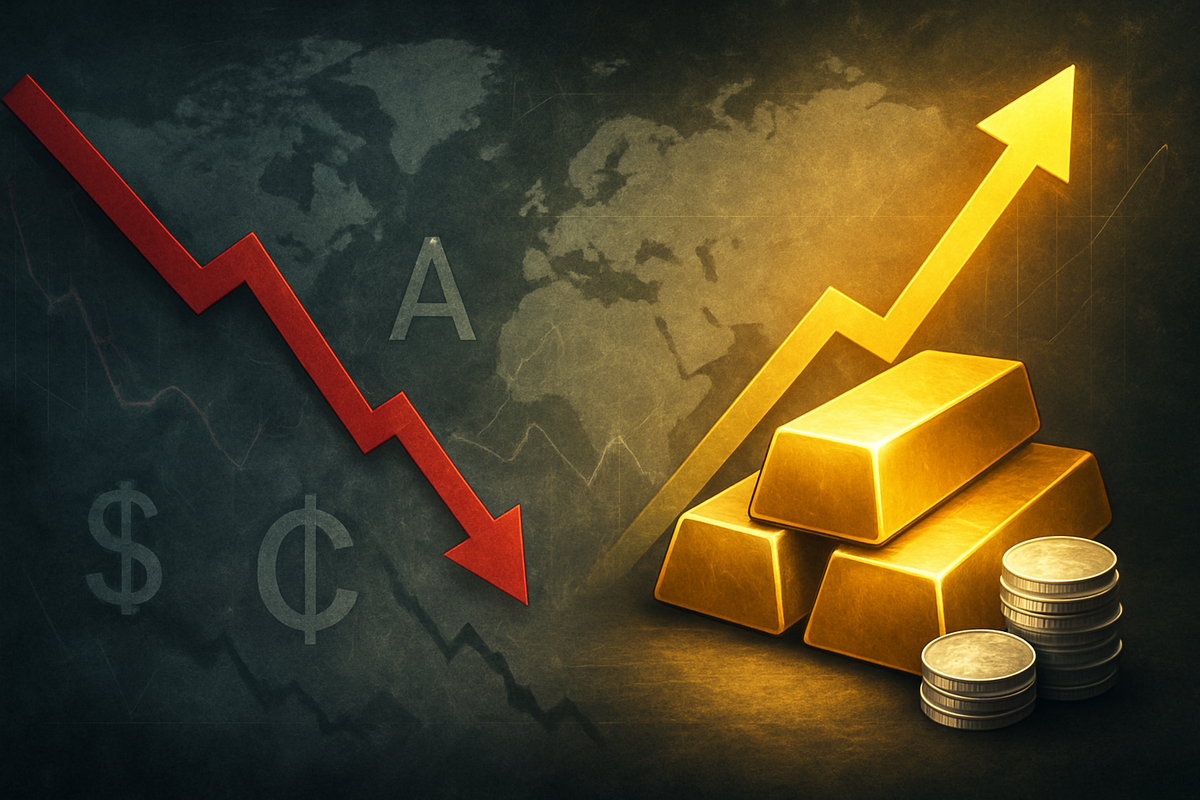
October 16, 2025 – Global financial markets are witnessing a dramatic shift today as commodity-linked currencies falter significantly, while gold and silver prices surge to unprecedented record highs. This pronounced divergence signals an intensifying "risk-off" sentiment among investors, who are rapidly reallocating capital from growth-sensitive assets to traditional safe havens amidst escalating global uncertainty. The immediate implication is a stark re-evaluation of economic stability, with implications for everything from international trade to central bank policies.
The unprecedented ascent of precious metals, coupled with the weakening of currencies tied to raw material exports, paints a clear picture of profound investor anxiety. This trend reflects deep-seated concerns over geopolitical instability, persistent inflationary pressures, and a potentially weakening global economic outlook. As the U.S. dollar simultaneously strengthens as another safe-haven, the financial landscape is undergoing a rapid recalibration, prompting urgent strategic considerations for businesses, governments, and individual investors alike.
Global Uncertainty Triggers Market Seismic Shift
Today's market movements are a direct consequence of a confluence of intensifying global uncertainties that have been simmering for months. A broad-based "risk-off" sentiment has gripped investors, leading to a significant contraction in demand for riskier assets. Specifically, the decline in commodity currencies—such as the Australian Dollar (AUD), Canadian Dollar (CAD), and other currencies from commodity-exporting nations—is largely attributable to a projected decrease in global industrial activity and consumer demand, which directly translates to lower prices for critical raw materials like oil, base metals, and agricultural products.
This negative demand shock has been exacerbated by ongoing geopolitical tensions across several key regions, which have heightened fears of supply chain disruptions and economic fragmentation. Additionally, persistent inflation worries in major economies, despite central bank efforts, have eroded confidence in fiat currencies, pushing investors towards tangible assets. The timeline leading to this moment has seen a gradual escalation of these factors, with various economic indicators and geopolitical events over the past year pointing towards increasing instability. Key stakeholders, including major institutional investors, central banks, and multinational corporations, are now scrambling to adjust their portfolios and strategies in response to these profound shifts, signaling a widespread loss of confidence in the near-term global economic outlook and a significant flight of capital towards perceived stability.
Companies Navigating the Precious Metal Boom and Commodity Currency Bust
The dramatic shift in currency and commodity markets creates a clear dichotomy of winners and losers across various sectors. Companies involved in the extraction and trading of precious metals are poised for significant gains, while those heavily reliant on commodity exports or exposed to the volatility of commodity currencies face considerable headwinds.
On the winning side, major gold and silver mining companies are experiencing a substantial boost to their revenue and profitability. Companies like Barrick Gold Corporation (NYSE: GOLD), Newmont Corporation (NYSE: NEM), and Wheaton Precious Metals Corp. (NYSE: WPM) are seeing their stock prices surge as the value of their primary products reaches record highs. These firms benefit directly from higher selling prices, improving their margins and attracting significant investor interest. Similarly, Exchange Traded Funds (ETFs) focused on precious metals, such as the SPDR Gold Shares (NYSEARCA: GLD) and iShares Silver Trust (NYSEARCA: SLV), are witnessing massive inflows of capital, reflecting the broader investor migration into safe-haven assets.
Conversely, companies operating in commodity-exporting nations, particularly those with significant foreign currency exposure, are likely to face challenges. For instance, manufacturers in Australia or Canada that rely on imported components paid for in a stronger U.S. dollar, while earning revenue in a depreciated local currency, will see their costs rise and profit margins squeezed. Furthermore, sectors that are highly sensitive to global demand for raw materials, such as heavy industry, automotive, and construction, could experience reduced sales volumes and profitability if the underlying global uncertainty leads to a sustained economic slowdown. Companies specializing in commodity trading for industrial purposes, rather than speculative precious metals, may also see reduced activity and profitability due to lower commodity prices and decreased global trade volumes.
Broader Implications: A Shifting Global Financial Architecture
The current market dynamic—faltering commodity currencies juxtaposed with soaring gold and silver prices—is more than a temporary blip; it signifies a profound recalibration within the global financial landscape. This event fits squarely into broader industry trends of de-dollarization and a strategic return to hard assets, particularly by central banks. Many nations, especially those within the BRICS bloc, have been steadily increasing their gold reserves, signaling a deliberate effort to diversify away from traditional reserve currencies and hedge against geopolitical and economic uncertainties. This accumulation provides strong structural support for gold prices and underscores a strategic push to reduce reliance on the U.S. dollar.
The ripple effects extend across the entire financial ecosystem. Competitors and partners in the commodity space must contend with increased volatility and shifting terms of trade. For instance, energy companies (e.g., ExxonMobil (NYSE: XOM), Shell (NYSE: SHEL)) may face challenges from lower oil demand impacting their upstream segments, even as they navigate currency fluctuations. Regulatory bodies and central banks are under immense pressure to reassess their monetary policies. Sustained high precious metal prices could prompt interventions or efforts to address underlying economic imbalances and geopolitical tensions. Historically, such flights to safety have often preceded or accompanied periods of significant economic restructuring or geopolitical realignments, such as the oil crises of the 1970s or the dot-com bubble burst, where investors sought refuge in tangible assets amidst uncertainty. The current situation echoes these historical precedents, highlighting a deep-seated lack of confidence in traditional financial instruments and a growing preference for tangible, inflation-protected assets.
The Path Forward: Navigating a Volatile Landscape
The immediate future for global markets appears characterized by heightened volatility and continued uncertainty. In the short term, investors are likely to maintain their defensive posture, favoring safe-haven assets. This could mean sustained demand for gold and silver, potentially pushing prices even higher, while commodity currencies remain under pressure. The U.S. dollar is also expected to retain its strength as a primary reserve currency amidst the global scramble for safety.
In the long term, this trend could necessitate significant strategic pivots for businesses and governments. Commodity-exporting nations may need to accelerate economic diversification efforts to reduce their reliance on volatile raw material markets. Companies, particularly those with international operations, will need to enhance their currency hedging strategies and scrutinize their supply chains for vulnerabilities to geopolitical risks. Market opportunities may emerge in sectors that provide stability or inflation protection, such as utilities, defensive consumer staples, and, of course, the precious metals industry itself. Conversely, challenges will persist for highly cyclical sectors and those deeply integrated into global trade networks that are susceptible to protectionist policies or economic slowdowns. Potential scenarios range from a gradual stabilization if global tensions ease and economic growth resumes, to a more prolonged period of economic stagnation and financial market fragmentation if uncertainties persist and deepen, forcing a more permanent re-evaluation of global trade and investment flows.
A New Era of Financial Prudence
Today's market movements underscore a pivotal moment in the global financial landscape: a pronounced shift towards prudence and tangible asset protection amidst pervasive uncertainty. The faltering of commodity currencies and the record-breaking surge of gold and silver are not isolated events but rather symptoms of deeper anxieties concerning global economic stability, persistent inflationary pressures, and an unpredictable geopolitical environment.
Moving forward, investors must prioritize diversification and a robust understanding of macroeconomic trends. The market is clearly signaling a preference for assets that offer a hedge against inflation and geopolitical risk, moving away from growth-oriented investments tied to global trade. What investors should watch for in the coming months includes any signs of de-escalation in global tensions, shifts in central bank monetary policies (particularly regarding interest rates and inflation targets), and economic data from major industrial nations that could indicate a change in global demand for commodities. The enduring strength of precious metals suggests that the era of easy money and unbridled globalization may be giving way to a more cautious and fragmented financial future, where tangible wealth preservation takes precedence.
This content is intended for informational purposes only and is not financial advice





